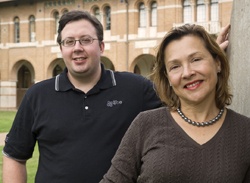Mar 13 2009
Researchers at Rice University have created a metamaterial that could light the way toward high-powered optics, ultra-efficient solar cells and even cloaking devices.
 Graduate student Nikolay Mirin (left) and Professor Naomi Halas have invented the first 3-D nano-antenna, a substance with the ability to bend light. Image: TOMMY LAVERGNE
Graduate student Nikolay Mirin (left) and Professor Naomi Halas have invented the first 3-D nano-antenna, a substance with the ability to bend light. Image: TOMMY LAVERGNE
Naomi Halas, an award-winning pioneer in nanophotonics, and graduate student Nikolay Mirin created a material that collects light from any direction and emits it in a single direction. The material uses very tiny, cup-shaped particles called nanocups.
In a paper in the February issue of the journal Nano Letters, co-authors Halas and Mirin explain how they isolated nanocups to create light-bending nanoparticles.
In earlier research, Mirin had been trying to make a thin gold film with nano-sized holes when it occurred to him the knocked-out bits were worth investigating. Previous work on gold nanocups gave researchers a sense of their properties, but until Mirin's revelation, nobody had found a way to lock ensembles of isolated nanocups to preserve their matching orientation.
"The truth is a lot of exciting science actually does fall in your lap by accident," said Halas, Rice's Stanley C. Moore Professor in Electrical and Computer Engineering and professor of chemistry and biomedical engineering. "The big breakthrough here was being able to lift the nanocups off of a structure and preserve their orientation. Then we could look specifically at the properties of these oriented nanostructures."
Mirin's solution involved thin layers of gold deposited from various angles onto polystyrene or latex nanoparticles that had been distributed randomly on a glass substrate. The cups that formed around the particles – and the dielectric particles themselves – were locked into an elastomer and lifted off of the substrate. "You end up with this transparent thing with structures all oriented the same way," he said.
In other words, he had a metamaterial, a substance that gets its properties from its structure and not its composition. Halas and Mirin found their new material particularly adept at capturing light from any direction and focusing it in a single direction.
Redirecting scattered light means none of it bounces off the metamaterial back into the eye of an observer. That essentially makes the material invisible. "Ideally, one should see exactly what is behind an object," said Mirin.
"The material should not only retransmit the color and brightness of what is behind, like squid or chameleons do, but also bend the light around, preserving the original phase information of the signal."
Halas said the embedded nanocups are the first true three-dimensional nanoantennas, and their light-bending properties are made possible by plasmons. Electrons inside plasmonic nanoparticles resonate with input from an outside electromagnetic source in the same way a drop of water will make ripples in a pool. The particles act the same way radio antennas do, with the ability to absorb and emit electromagnetic waves that, in this case, includes visible wavelengths.
Because nanocup ensembles can focus light in a specific direction no matter where the incident light is coming, they make pretty good candidates for, say, thermal solar power. A solar panel that doesn't have to track the sun yet focuses light into a beam that's always on target would save a lot of money on machinery.
Solar-generated power of all kinds would benefit, said Halas. "In solar cells, about 80 percent of the light passes right through the device. And there's a huge amount of interest in making cells as thin as possible for many reasons."
Halas said the thinner a cell gets, the more transparent it becomes. "So ways in which you can divert light into the active region of the device can be very useful. That's a direction that needs to be pursued," she said.
Using nanocup metamaterial to transmit optical signals between computer chips has potential, she said, and enhanced spectroscopy and superlenses are also viable possibilities.
"We'd like to implement these into some sort of useful device," said Halas of her team's next steps. "We would also like to make several variations. We're looking at the fundamental aspects of the geometry, how we can manipulate it, and how we can control it better.
"Probably the most interesting application is something we not only haven't thought of yet, but might not be able to conceive for quite some time."